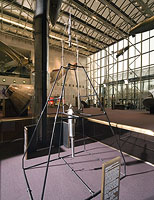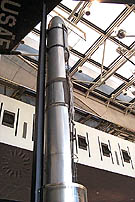![]()
![]()
Goddard Rocket (1926) This is a replica of Robert H. Goddard's first liquid-propellant rocket to achieve flight. The original rocket, launched on March 16, 1926, at Auburn, Massachusetts, was damaged upon impact. The flight reached an altitude of 12 meters (41 feet), lasted 2.5 seconds, and covered a horizontal distance of 56 meters (184 feet). Goddard experimented with liquid-propellant rockets before anyone else, but details of his work were so poorly known that he had little direct influence on later technological developments. He worked alone and was reluctant to publicize his results. Although there was limited military or commercial interest in rocket technology at the time, the Smithsonian Institution and private philanthropic foundations funded his early research. Transferred from the National Aeronautics and Space Administration. Design Features: Goddard recognized that liquid propellants could provide more energy for propulsion than an equal weight of gunpowder or other available solid fuels. In his earliest rockets, he placed the engine at the top of the vehicle and the fuel tanks below. However, he soon found that this "nose drive" arrangement was too unstable, so he placed the motor at the bottom, as in all modern rockets. Almost all of Goddard's liquid-propellant rockets burned liquid oxygen and gasoline.
Goddard's later rockets used his own custom-made, lightweight turbopumps to force the propellants into the combustion chamber, automatic stabilization, thermally insulated propellant tanks, and combustion chamber cooling. Refined versions of these features are found in most modern rocket designs. Goddard did not realize it, but since the early 1930s the German army had been secretly developing liquid-propellant rockets and had independently arrived at similar engineering solutions.
|
||||||||||||||||||||||
![]() 1903
Wright Flyer | Milestones of Flight |
1927 Spirit of St. Louis
1903
Wright Flyer | Milestones of Flight |
1927 Spirit of St. Louis ![]()
©National Air and Space Museum

